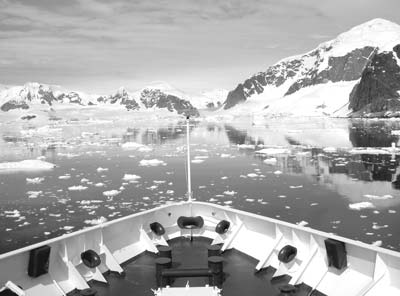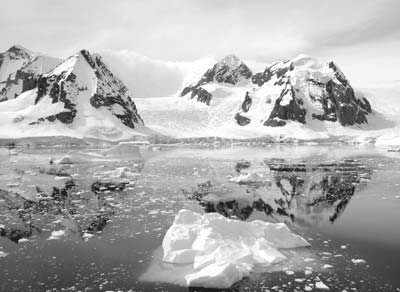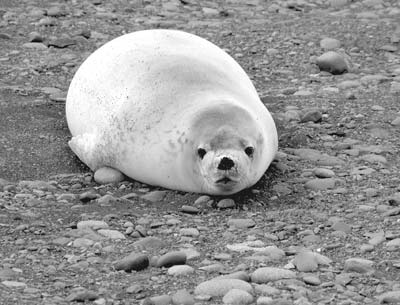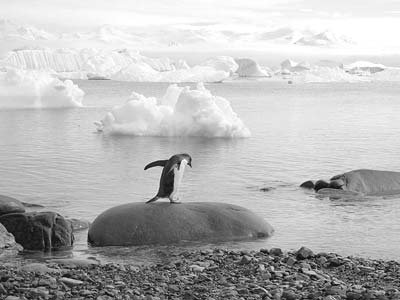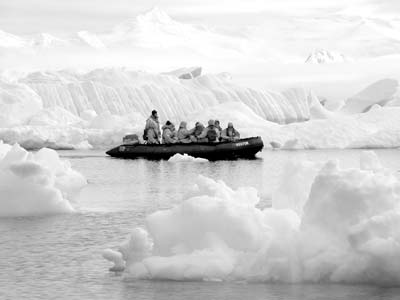Antarctica — 'exquisite beyond words'
by Lesley Friedsam, Tampa, FL
I am walking on an ice floe atop the Southern Ocean, the most inhospitable sea on Earth. The only thing between me and a thousand feet of water filled with orcas, whales, penguins and seals is a 2-foot-deep crust of white, blue, gray and turquoise ice. The ice is not a flat, shiny sheet. It is raised and humped, crevassed and sculptured. Gigantic icebergs, some multistories high and a city block long, are part of this landscape created by summer meltings and winter freezings.
This is not a nightmare. It is a dream come true.
I had plenty of company on this December ’02 journey. Mischievous, cooing, braying, squeaking and squawking chinstrap and Adélie penguins provided entertainment as, flipper wings outstretched, they teeter-tottered down well-worn frozen paths to bathe and groom.
The Adélies didn’t just wobble, they tobogganed downhill over slippery white expanses on krill-filled fat bellies.
Gray-spotted leopard seals, full of penguin suppers, slept lazily on the floating ice while less ferocious-looking Weddell seals claimed the shorelines. I spotted tiny newborn pups, furry white with liquid, haunting eyes, nursing at their sides.
Antarctica is the world’s coldest, driest, windiest continent. It is also exquisite beyond words.
The ship
My passage to the ice was on a little blue boat, the World Discoverer, sparklingly refurbished in 2002 by Society Expeditions, a German-owned company. Although there are about a dozen ships taking upward of 15,000 visitors south each season, I chose this company because of their 25 years of Antarctic experience.
The World Discoverer is an ice-hardened ship with stabilizers, not an icebreaker — a comfort choice. At 354 feet in length, with a capacity for 160 passengers and well tended by a crew of 90, the ship was large enough for comfort but unobtrusive in the pristine wilderness. While I had the tiniest cabin on the lowest deck, I enjoyed side-by-side beds, a full marble bathtub with unlimited hot water, porthole views, a mini-bar and plenty of storage space.
Billed as an expedition, not a cruise, there were no faux Las Vegas reviews, slot machines or midnight buffets. Instead there were lectures from geologists, ornithologists and marine biologists. I could also watch the lectures and next-day briefings from my cabin via closed circuit on a wide-screen, LCD, state-of-the-art television.
The library offered free e-mail, which I used daily to capture my travel diary and send it home to friends and family.
Dining on board
Breakfast, after witty wake-up calls from the expedition leader, was a bountiful buffet. Midday and evening meals brought options: a quick smorgasbord in the panoramic lounge or leisurely, multicourse European cuisine, beautifully plated and served by handsome, charming, multinational waitpersons who also graciously poured the fine, no-extra-cost house wines. I am still wondering how, after 18 days at sea, the lettuce remained fresh and bountiful.
While the food was elegant, attire was casual, and I was pleased to dine with people from Europe and beyond as seating was not assigned. Because my voyage coincided with the holidays, I celebrated Christmas Eve German style with roast goose, suckling pig and red cabbage. Christmas Day brought Yankee turkey with chestnut stuffing and home-style mashed potatoes.
The journey begins
After a Society Expeditions-scheduled overnight in Santiago and a charter flight, the 3-week expedition began in Ushuaia, the fin del mundo at the southernmost tip of Argentina.
The itinerary traced backward part of the route of Sir Ernest Shackleton, famous for saving all his men after a shipwreck, ice camping and a harrowing open-boat journey. First was the Falklands, followed by South Georgia, Elephant Island and, finally, Antarctica.
Although the Southern Ocean is infamous for gales and weather extremes, our trip was windless, with warm weather. Because we had 20 hours of daylight, the sun never completely set. Instead, we were treated to lingering semisunsets with bands of purple, scarlet, coral and gold dancing across the cloudless sky and ice-filled ocean.
Armed with Transderm Scop® patches, I avoided the unpleasant fate that several folks endured that first day before their sea legs steadied them.
Landings were all made by Zodiac. The first Falklands day provided a short, easy, overland hike among four penguin species: Magellanic, gentoo, rockhopper and macaroni, the latter so named for its bright yellow eyebrow plumage.
The third day brought us Port Stanley, a picturesque town complete with British pubs, a church framed by whalebone arches and a charming museum filled with turn-of-the-century photographs and artifacts plus a special section dedicated to the 1982 conflict with Argentina.
Sailing past the latitudes of the furious 40s and into the roaring 50s, I journeyed south beyond the Antarctic convergence. This imaginary line, which circles the continent, is the meeting point of the warmer northern oceans and frigid Antarctic seas. Below the convergence begins the abundance of tiny life-forms that sustains the higher food chain. Shrimplike krill feed the baleen whales, seabirds and penguins. Penguins feed the seals and orcas.
Harsh existence
After two days at sea, the ship anchored off South Georgia, a subantarctic oasis. Known as the Galápagos of the South, it teems with wildlife.
At Salisbury Plain, as far as I could see there were hundreds of thousands of king penguin mated pairs tending brown, fluffy chicks.
At another landing I climbed a steep hill through a cordon of menacing, bellowing fur seals, which were safely kept at bay by the expedition staff. My reward was a close-up view of nests of the sailors’ traditional friend, the wandering albatross.
These magnificent birds, with the largest wingspan in the world, soar on currents above the Southern Ocean with nary a wing flap needed on their search for food before returning to this, their natal island, to nest and breed seven years after fledging.
Less graceful wildlife was plentiful as well. The South Georgia shorelines often were dotted with blubbery, massive elephant seals that grunted and pushed against each other in macho displays.
On Christmas Eve day, near the ruins of the whaling station at Grytviken, the captain, my shipmates and I toasted Sir Ernest at his gravesite and met the four brave people who still live there, faithfully tending the historic museum and church.
The lure of the ice
Sailing farther south, the largest animal in the world, a mighty blue whale, breached on the port side one morning, causing the captain, who had never before seen a blue, to cry out, “Marine biologist to the bridge!”
The excitement increased. Luckily, a rare landing was made at usually icebound, unreachable Elephant Island, home for most of Shackleton’s men while they waited 128 days for the return of their “Boss.” I stood on legendary Point Wild, gazing at the monument commemorating the rescue, now overrun with chinstrap penguins.
I did not win the “first iceberg spotting” contest, but it mattered not. At times I boarded Zodiacs simply to glide silently among the bergs, curved and twisted, the austral summer light enhancing the depth of field for my new digital camera, with which I tried to capture the wonder surrounding me.
The refracted light danced between water, ice and sky and I became enveloped and lost in the towering, wondrous dreamscape.
One such magical place, the narrow Lemaire Channel off the Antarctic Peninsula, is nicknamed Kodak Gap. If I rightly recall, I shot an hour of videotape in this spot alone.
Near the end of the voyage, on a day in the Weddell Sea, the captain put the beak of the bow into the ice. Crunch. The ship was temporarily surrounded.
My new best mate for the trip, Barrie, one of Tony Blair’s barristers, had been there before: “The penguins are always clever and the blue whale sighting was brilliant, but I came back for the ice.”
As Shackleton wrote in his diary when his ship was beset by the pack, “What the ice gets, the ice keeps.”
In all my travels, I have never made a U-turn back to the same place two years in a row. Following this trip, I arranged a return to the ice with Society Expeditions in December 2003.
Society Expeditions to Antarctica
Society Expeditions can be reached at 2001 Western Ave., Ste. 300, Seattle, WA 98121; phone 800/548-8669 or 206/728-9400, fax 206/728-2301 or visit www.societyexpeditions.com.
I paid $12,000-plus, including airfare from Miami, for the least expensive cabin. All inclusive. No tipping!
The season runs November to February. Book well in advance, as the ship sells out regularly. I suggest taking a digital camera with a powerful zoom lens and mega-memory cards or your laptop so that you can take unlimited photographs.



